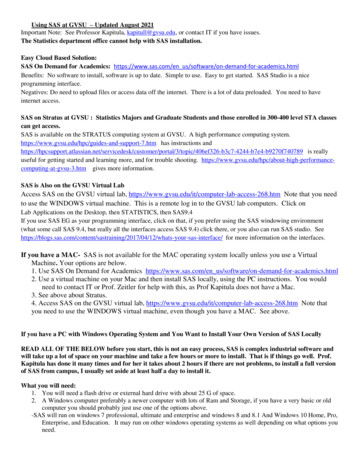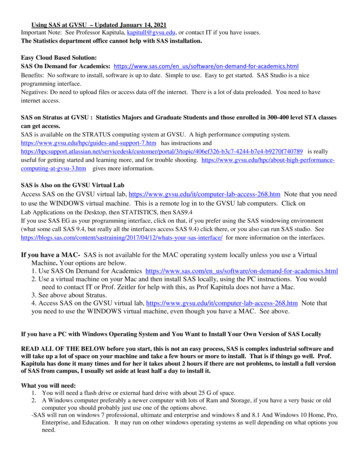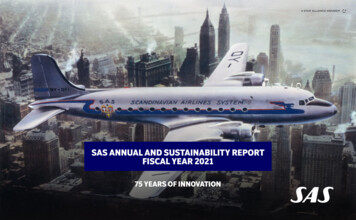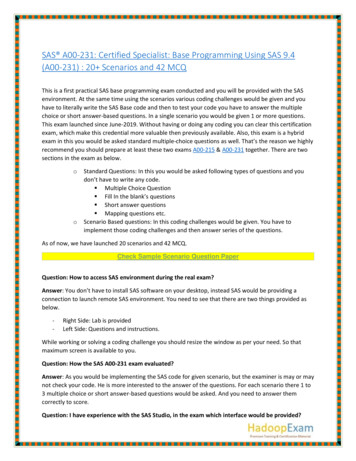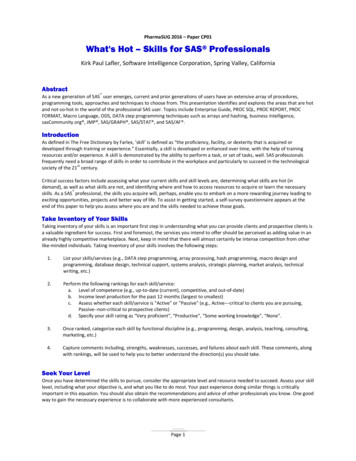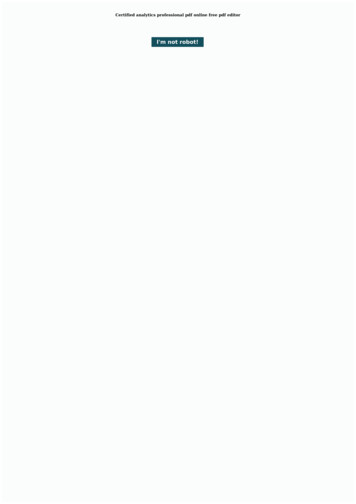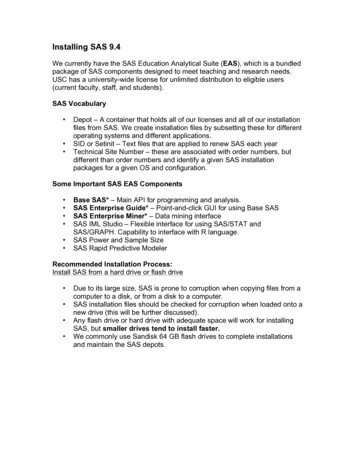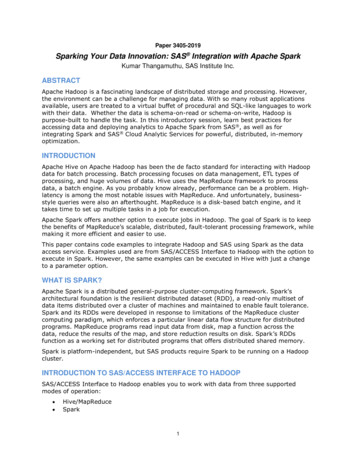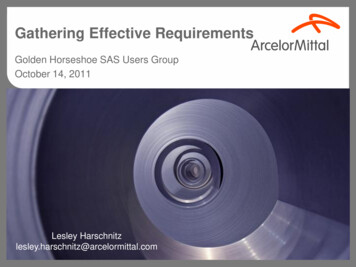
Transcription
Gathering Effective RequirementsGolden Horseshoe SAS Users GroupOctober 14, 2011Lesley Harschnitzlesley.harschnitz@arcelormittal.com
Overview IntroductionPlanning to Gather RequirementsGathering ProcessWhat Not to MissSummaryOctober 14, 2011 ArcelorMittal Dofasco, 20112
Introduction Objectives:– Encourage you to treat requirements gathering as a process.– Provide some starting points for you to work from. Basis for talk:– Gathering effective requirements is known to be critical to success.– Using a generic hypothetical example.– Defined IT project with IT deliverables.October 14, 2011 ArcelorMittal Dofasco, 20113
Requirement Definitions Characteristic of performance or functionality that the end product mustmeet or exceed. Effective requirements are:– Complete– Specific– Separated into must have and optional.– Measureable– Prioritized– Achievable– Connected– Signed off by the client(s)October 14, 2011 ArcelorMittal Dofasco, 20114
Requirement sData tsBusinessProcessTechnicalRequirementsOctober 14, 2011 ArcelorMittal Dofasco, 2011FinalDeliverable5
Process of Gathering RequirementsCycle EntryCycle hopReviewRequirements gathering is iterative and cyclicalOctober 14, 2011 ArcelorMittal Dofasco, 20116
Planning for Requirements GatheringOctober 14, 2011 ArcelorMittal Dofasco, 20117
Planning for Requirements GatheringStep 1: Review the Project Scope Business Process – What business outcome is needed? Stakeholders- Who are the stakeholders, and how manybusiness areas do they represent? Is this independent development or modifications to an existingsystem? What are the constraints- time, project, etc? What is the development method – waterfall, iterative? Who is sponsoring the project?We are estimating the time needed for requirements gathering, the number ofdifferent stakeholder groups, and any possible areas of disagreement.October 14, 2011 ArcelorMittal Dofasco, 20118
Planning for Requirements GatheringStep 2: Identify the Interfaces and Constraints Where are the interactions?– What systems are providing inputs?– What systems require outputs? What are the constraints?– Infrastructure standards, guidelines– Architectural standards in products and toolsCan we identify some of the boundaries?Are some of the requirements pre-determined?October 14, 2011 ArcelorMittal Dofasco, 20119
Planning for Requirements GatheringStep 3: Plan the execution of the process Ensure client resources are available and committed. Look for strong subject matter expertsLook for diversityPlan to engage groups separately if neededEnsure activities are time boxed and allow for reviewtimesClearly identify deliverables and their formats.Plan follow up timeCreate a plan that matches the development method, ensures that the resourcesunderstand the full commitment, and sets an expectation for the deliverables and dates.October 14, 2011 ArcelorMittal Dofasco, 201110
Gathering Process Book short, specific workshops (2-3 hours max) Facilitate Have an agenda and templates Have a parking lot for issues Separate functional from technical Discuss discovered constraints at the first workshop Have the right equipment- projector, computer, flip chart Stay on task and on schedule at each workshopEnsure that the business process is understood first Identify process steps Identify expected inputs, outcomes, measures,business rules Plan to iterate as requirements gathering continuesOctober 14, 2011 ArcelorMittal Dofasco, 201111
Gathering Process- Example Fictitious Call Centrethat receives customerinquiries Have been keepingtrack on paper Want an electronic dataentry systemOctober 14, 2011 ArcelorMittal Dofasco, 201112
Example template- functional escription:Rationale:Business facesRequirementType:Must havePreferredAdditionalBusiness Rules:October 14, 2011 ArcelorMittal Dofasco, 201113
Example:Date:RequirementName:Call recordBusinessFunction:Record customer phone inquiries- Initial contact recordDescription:Electronic form that collects data as listed in supporting spreadsheetCustomerInquiry.xls (Initial Call tab)Rationale:Collect a consistent and complete set of data to support the follow uprequirementsBusiness Source:Jane SmithAcceptanceMeasure:Form collects all required information in the correct format.Dependencies/Interfaces:Uses current customer tablesUses electronic form development stdsAdditional BusinessRules:Business Day: 8:00:00 AM to 9:00:00 PM- outside hours calls to be clearlyidentified.SLA to respond to messages within 24 hoursOctober 14, 2011Tester: ArcelorMittal Dofasco, 201109/23/11George DoeRequirementType:Must have14
Example data collection template:ItemMeaningTypeLengthAllowedValuesData ModelOctober 14, 2011 ArcelorMittal Dofasco, 201115
Example:ItemMeaningTypeLenAllowedValuesCustomerThe identity of the person who is callingChar30AnyCharPhone #Contact Telephone NumberChar13InternationalformatEmailContact email addressChar30Valid emailCall TranscriptA free flow record of the customer dr2WkPhoneMbPhoneCEmailOctober 14, 2011CUST INQCustIDSPhoneSEmailInqText ArcelorMittal Dofasco, 201116
Example technical requirement templateApplication y:Support Level:October 14, 2011 ArcelorMittal Dofasco, 201117
Example:Application Name:Customer Inquiry RecordBusinessFunction:Collect information from phone based customer inquiries that facilitates followup calls.Description:Web based system for data collection.Availability:6 am to 6 pm Monday to FridayReliability:Always on – power outages exceptedPerformance:3 second screen refresh after commitSecurity:Internal use onlyArchive:Daily 8 pmRecovery:3 hoursSupport Level:Work to completionOctober 14, 2011 ArcelorMittal Dofasco, 2011Date:10/14/1118
Ending the process Use the requirements documents tocreate a system test plan.– Provides an additional deliverable– Helps validate that requirementsare effective. Have the clients sign off on therequirements.October 14, 2011 ArcelorMittal Dofasco, 201119
What not to missThings that can and do slip through unnoticed to causerework and more work.October 14, 2011 ArcelorMittal Dofasco, 201120
What not to miss Common terms that have uncommon meanings TIME– Exact definition in date time format– Week- starts when?– Month- starts when?October 14, 2011 ArcelorMittal Dofasco, 201121
What not to miss Metadata Consistency– If it already has a name, stick with it– Pay attention to allowed values Definitions– Business language, complete sentencesand validated with stakeholders. Historical Aspects of data– Data analysis concerns– Timestamps, order of events– Data warehouse needsOctober 14, 2011 ArcelorMittal Dofasco, 201122
What not to miss Business Rules:– A rule of operation that is not apparentfrom the description of the process.– Can be very fluid and diverse– Often used to deal with exceptions– Supplements the definition of a business term. Examples:– We allow 5 contacts for a customer (except for our top 10 customerswho are allowed as many as they wish)– We do not follow up customer complaints outside of business hoursexcept by customer request.– We never ship direct to a retail customer by courierOctober 14, 2011 ArcelorMittal Dofasco, 201123
What not to miss Technical requirements– Establish early– Manage client expectations. Constraints– Discover Early– Check all types- organization, software, hardware, process Iteration and signoff– Need at least 2 review cycles– Follow up with folks who do not respond to review requests– Need signoff by clients and/or sponsorsOctober 14, 2011 ArcelorMittal Dofasco, 201124
What not to miss Requirements will change after signoff- manage actively Have a process that includes:– Document the change – reuse the templates– Assess the impact, especially The need for rework The need for different or additional resources The benefit of the change– Have client signoff against the impact– Have a pre-determined freeze pointOctober 14, 2011 ArcelorMittal Dofasco, 201125
Summary Effective requirements :– Complete– Specific– Necessary/Optional– Measureable– Prioritized– Achievable– Connected– Signed off by theclient(s) Gathering Tools include:– Templates– Base documents– Checklists– Workshops– Signoff– Change ProcessRequirements gathering is an iterative and cyclical processthat should beplanned, managed and controlledOctober 14, 2011 ArcelorMittal Dofasco, 201126
Questions, Contact Lesley er 14, 2011 ArcelorMittal Dofasco, 201127
-Encourage you to treat requirements gathering as a process. -Provide some starting points for you to work from. Basis for talk: -Gathering effective requirements is known to be critical to success. -Using a generic hypothetical example. -Defined IT project with IT deliverables.
